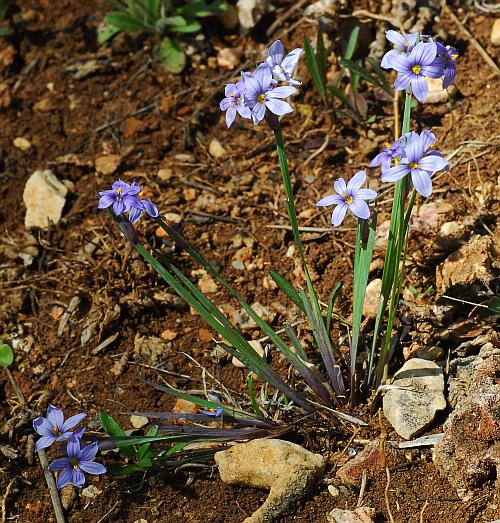Sisyrinchium campestre E.P. Bicknell
Prairie Blue-Eyed Grass

Native
CC = 5
CW = 5
MOC = 77
© SRTurner
Sisyrinchium campestre E.P. BicknellPrairie Blue-Eyed Grass | |
 |
Native CC = 5 CW = 5 MOC = 77 |
© SRTurner |
|
Family - Iridaceae Habit - Perennial forb with fibrous roots, lacking rhizomes. Stems - Ascending to erect, to 45 cm, flattened, 1.0-3.5 mm wide, unbranched, most commonly narrowly winged.
Leaves - Basal or nearly so, few, linear, the leaf blades flat, 1.0-3.5 mm wide.
Inflorescences - Inflorescence 1 per aerial stem, sessile at the stem tip, lacking a subtending leaflike bract. Flowers 2-12, subtended by two spathelike bracts, these 1.3-5.5 cm long, green, sometimes purplish tinged, the outer bract leaflike, 1.5-2.0 times as long as the inner bract.
Flowers - Flowers with stalks 8-18 mm long. Perianth 5-12 mm long, spreading, usually blue but occasionally white or purple, usually with a well-developed yellow "eye" at the base, the sepals and petals similar and fused at the bases, oblanceolate with the tips abruptly narrowed into an attenuate tip, sometimes with the attenuation protruding from an apical notch. Styles with 3 linear lobes. Stamens with the filaments fused to the tips or nearly so.
Fruits - Capsules 2-6 mm long, globose. Seeds black, globose. Flowering - April - June. Habitat - Prairies, glades, upland forests, pastures, thin soils along railroads. Origin - Native to the U.S. Lookalikes - Other species within the genus. Other info. - This pretty little species is common throughout most of Missouri. Its U.S. distribution is largely defined by a Midwestern oval "blob" ranging from Minnesota down through Arkansas and Oklahoma. Unlike many other Missouri plants, its range does not extend significantly eastward. Photographs taken in the Piney Creek Wilderness, Barry County, MO., 4-4-04, at Whetstone Conservation Area, Callaway County, MO., 5-4-04, and in Ripley County, MO., 5-14-04 (DETenaglia); also at Valley View Glade Natural Area, Jefferson County, MO, 4-10-2010, and St. Joe State Park, St. Francois County, MO, 5-3-2014 and 4-26-2020 (SRTurner). |